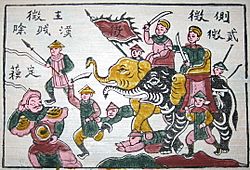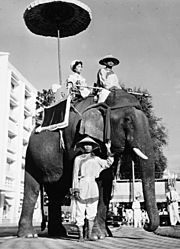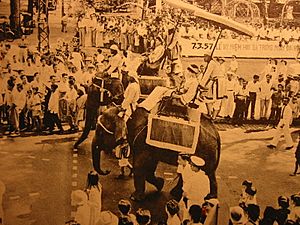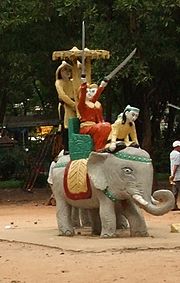Trưng sisters facts for kids
Quick facts for kids Trưng Sisters |
|

The Trưng sisters ride elephants into battle in this Đông Hồ style painting.
|
|
| Vietnamese | Hai Bà Trưng |
|---|---|
| Hán-Nôm | 𠄩婆徵 |
| Literal meaning | Two ladies Trưng |
The Trưng sisters (Vietnamese: Hai Bà Trưng, 𠄩婆徵, literally "Two Ladies [named] Trưng", c. 14 – c. 43) were Vietnamese military leaders who ruled for three years after rebelling in AD 40 against the first Chinese domination of Vietnam. They are regarded as national heroines of Vietnam. Their names were Trưng Trắc (Hán tự: 徵側; Chinese pinyin: Zheng Ce; Wade–Giles: Cheng1 Ts'e2) and Trưng Nhị (Hán tự: 徵貳; Chinese pinyin: Zheng Er ; Wade–Giles: Cheng1 Erh4). Trưng Trắc was the first woman to be a Vietnamese monarch, as well as the only queen regnant in the history of Vietnam (Lý Chiêu Hoàng was the second woman to take the reign and is the only empress regnant), and she was accorded the title Queen Trưng (Chữ Quốc ngữ: Trưng Nữ vương, Hán tự: 徵女王) in Đại Việt sử ký toàn thư.
The sisters were born in Jiaozhi, Vietnamese Giao Chỉ, in rural northern Vietnam, a commandery of the Han dynasty (and in modern Northern Vietnam). The dates of their births are unknown, but Trưng Trắc was older than Trưng Nhị. The exact dates of their deaths are also unknown but both died around 43 AD after battling against the punitive expedition force led by Ma Yuan.
The Trưng sisters were highly educated under the watchful eyes of their father; they excelled in both literature and martial arts. Both were in line to inherit their father's land and titles.
Contents
Historical background
The former Qin commander Zhao Tuo established the state of Nanyue in 204 BC and had conquered Âu Lạc in 180 BC, incorporating the Vietnamese realm under Han rule. In 112 BC, Emperor Wu of Han dispatched soldiers against Nanyue and the kingdom was annexed in 111 BC during the ensuing Han conquest of Nanyue. Nine commanderies were established to administer the region, three of which were located in what is now northern Vietnam. Revolts of local tribes against the Han began in 40 AD led by the Trưng sisters.
Biography
The Trưng sisters were daughters of a wealthy aristocratic family of Lạc ethnicity (The Lac were sorts of a confederation of multi-ethnic peoples). Their father had been a Lạc lord in Mê Linh district (modern-day Mê Linh District, Hanoi). Trưng Trắc's husband was Thi Sách (Shi Suo), was also the Lạc lord of Chu Diên (modern-day Khoái Châu District, Hưng Yên Province). Su Ding, the Chinese governor of Jiaozhi province at the time, is remembered by his cruelty and tyranny. According to the Book of the Later Han, Thi Sách was "of a fierce temperament", and Su Ding attempted to restrain him with legal procedures, literally to behead him without trial. Trưng Trắc stirred her husband to action and became the central figure in mobilizing the Lạc lords against the Chinese. In March of 40 AD, Trưng Trắc and her younger sister Trưng Nhị, led the Lạc Việt to rise up in rebellion against the Han.
The Book of the Later Han recorded that Trưng Trắc launched the rebellion to avenge the killing of her husband. It began at the Red River Delta, but soon spread to other Lạc and non-Han peoples from an area stretching from Hepu Commandery to Rinan. Chinese settlements were overrun, and Su Ding fled. The uprising gained the support of about sixty-five towns and settlements. Trưng Trắc was proclaimed as queen regnant.
In 42 AD, the Han emperor commissioned general Ma Yuan to suppress the rebellion with 20,000 troops. The rebellion of the two sisters was defeated in the next year as Ma Yuan captured and executed Trưng Trắc and Trưng Nhị, then sent their heads to the Han court in Luoyang.
The Song dynasty poet and calligrapher Huang Tingjian (1045–1105) compared the Trưng sisters to Lü Jia, the prime minister of Nanyue who resisted Han Wu Di's army in 112 BCE:
Lü Jia refused treasonous brides;
Trưng Trắc raised her shield to resist oppression
Historiography
The primary historical source for the sisters is the 5th century Book of the Later Han compiled by historian Fan Ye, which covers the history of the Han Dynasty from 6 to CE 189. The secondary source, but the primary popular source, is the Đại Việt sử ký toàn thư (Complete Annals of Dai Viet) compiled by Ngô Sĩ Liên under the order of the Emperor Lê Thánh Tông and finished in 1479.
Vietnamese chronicles
Excerpts from Complete Annals of Đại Việt, 1479
The third book of Đại Việt sử ký toàn thư (Complete Annals of Dai Viet), published in editions between 1272 and 1697, has the following to say about the Trưng Sisters:
In the year Kỉ Hợi [Ji Hai, 39 AD] (It was the 15th year of the era of Emperor Guang Wu of Han, Liu Xiu), the administrator of Jiaozhi, Su Ding, governed with greed and violence. Queen Trưng raised troops and attacked.
[...]
Queen Trưng reigned for three years. The queen was remarkably strong and courageous. She expelled Su Ding and established a nation as queen, but as a female ruler, she could not accomplish the rebuilding [of the nation]. Her taboo name was Trắc, and her family name was Trưng, but was originally Lạc (雒). She was the daughter of a Lạc general from Mê Linh from Phong Châu, and she was the wife of Thi Sách from Chu Diên County. Thi Sách was the son of another Lạc general, and the child of each of both houses married each other. ([Wang Youxue's] Collected Overview of the Outlines and Details (of the Comprehensive Mirror in Aid of Governance) ([資治通鑒]綱目集覽) erroneously indicated that his family name was Lạc.) Her capital was Mê Linh. [...]
Her first year was Canh Tí [Gengzi, 40 AD]. (It was the 16th year of Han Dynasty's Jianwu era). In the spring, the second month, the queen was bitter because the governor, Su Ding, used the law to restrain her and also harbored a grudge against him for having killed her husband. She, therefore, along with her younger sister Nhị, rose and captured the commandery capital. Ding was forced to flee. Nam Hải, Cửu Chân, Nhật Nam, and Hợp Phố all rose in response to her. She was able to take over 65 cities and declare herself Queen. Thereafter, she began to use the family name of Trưng.
Her second year was Tân Sửu [Xinchou, 41 AD]. (It was the 17th year of Han Dynasty's Jianwu era). In the spring, the second month, there was a solar eclipse on the last day of the (lunar) month. The Han court, witnessing that as Lady Trưng had declared herself queen, captured cities, caused much distress in the border commanderies, thus ordered Trường Sa, Hợp Phố, and Giao Châu ([now] ours) to prepare wagons and boats, repair the bridges and the roads, dredge the waterways, and store foods and provisions, and also commissioned Wave-Subduing General Ma Yuan and Fule marquis Liu Long as his assistant in order to invade.
Her third year was Nhâm Dần [Renyin, 42 AD]. (It was the 18th year of Han Dynasty's Jianwu era). In the spring, the first month, Ma advanced, following the coastline and the mountain(paths). He went for over a thousand li and reached Lãng Bạc (west of Tây Nhai in La Thành was (a place) named Lãng Bạc). He battled with the queen, who saw that the enemy's army was large. She herself considered her army to be disorderly and feared that it could not stand. Therefore, she withdrew to Forbidden (禁 Jìn) Gorge. (The Forbidden Gorge was referred to in history as Golden (金 Jīn) Gorge.) The army also thought that the queen was a woman and could not win, and therefore scattered. The national continuation again ended.
[...]
Her fourth year was Quý Mão [Guimao 43 AD]. (It was the 19th year of Han Dynasty's Jianwu era). In the spring, the first moth, Queen Trưng and her younger sister warred against Han army; they were abandoned and both were defeated and perished. Ma Yuan chased down the remaining multitude, Đô Dương and others. When chased to Cư Phong prefecture, [Đô Dương and others] surrendered.
[...]
The locals admired and mourned the Trưng Queens; they erected a temple for worshipping. The temple is located at in Hát River commune, Phúc Lộc Prefecture; there is also (another temple?) in the old territory of Phiên Ngung.
Lê Văn Hưu (Trần dynasty's historian) wrote:
Trưng Trắc, Trưng Nhị are women; with one single cry [they rallied] the commanderies of Cửu Chân, Nhật Nam, Hợp Phố; and sixty-five strongholds beyond the ridge heeded their call. They established a nation and proclaimed themselves as queens as easily as their turning over their hands. We can see that we Viets have the potentials to achieve the status of hegemons and monarchs. Regrettably, since after the Triệu dynasty until before Ngô Quyền, in the span of more than one thousand years, the men themselves merely hung their heads, wrung their hands, and became vassals and servants to Northerners (Chinese). Don't they men feel ashamed considering that the two Trưng were women? Alas! They may say they have thrown themselves away. The reign of Trưng Queens started in the year of Canh Tý and ended in Nhâm Dần, for a total of 3 years (40–42).
Ngô Sĩ Liên (the Complete Annals chief compiler) wrote:
Lady Trưng was infuriated by the oppressive Han administrator. With her raised arm and one single yell, she almost rebuilt our Viet national continuation. Her heroic mettle during her lifetime not only prompted her nation-building and proclamation of queenship but also, even after she perished, hamper disaster and hinder peril. Whenever disasters, like flood or drought, happen, no prayers go unanswered. The same for the younger Trưng sister. For she, a woman, possessed the gentleman's virtue, and her heroic and courageous spirit, between heaven and earth, does not deteriorate even though her body alrealdy perished. Couldn't men have nourished that upright and honest spirit?
Cultural significance
Nationalism
The Trưng Sisters are highly revered in Vietnam, as they led the first resistance movement against the occupying Chinese after 247 years of domination. Many temples are dedicated to them, and a yearly holiday in February to commemorate their deaths is observed by many Vietnamese. A central district in Hanoi called the Hai Bà Trưng District is named after them, as are numerous large streets in major cities and many schools. Their biographies are mentioned in children's school books.
The stories of the Trưng Sisters and of another famous woman warrior, Lady Triệu, are cited by some historians as hints that Vietnamese society before sinicization was a matriarchal one, where there are no obstacles for women in assuming leadership roles.
Even though the Trưng Sisters' revolt against the Chinese was almost 2000 years ago, its legacy in Vietnam remains. The two sisters are considered to be a national symbol in Vietnam, representing Vietnam's independence. They are often depicted as two women riding two giant war elephants. Many times, they are seen leading their followers into battle against the Chinese. The Trưng sisters were more than two sisters that gave their life up for their country; they are powerful symbols of Vietnamese resistance and freedom.
Temples
Temples to the Trưng Sisters or Hai Bà Trưng Temples were found from as early as the end of the Third Era of Northern Domination. The best known Hai Bà Trưng Temple is in Hanoi near Hoàn Kiếm Lake. The temple was constructed by king Lý Anh Tông (r. 1138–1176) in 1158. According to tradition, in that year a devastating drought occurred in the Red River Delta, and the king ordered a Buddhist monk named Cam Thin to conduct a sacrifices rite and pray for rain at the Trung sisters temple. It rained the following day that saved his kingdom from famine. During one night the king dreamed and saw the two sisters appeared and were riding together on an iron horse. When the king awoke, he ordered the temple to be gloriously decorated and performed a sacrifice ritual to the sisters. Later he had other two temples to worship the sisters, which one was destroyed by river landslide and another one temple which still being today. Other Hai Bà Trưng temples are found in Mê Linh District (Vĩnh Phúc Province), Phúc Thọ District (Hà Tây Province) and Hoàng Hoa Thám Street, Bình Thạnh District, Ho Chi Minh City.
Women's status
One reason for the defeat is desertion by rebels because they did not believe they could win under a woman's leadership. The fact that women were in charge was blamed as a reason for the defeat by historical Vietnamese texts in which the historians ridiculed and mocked men because they did nothing while "mere girls", whom they viewed with revulsion, took up the banner of revolt. The historical poem containing the phrase "mere girls", which related the revolt of the Trung Sisters while the men did nothing, was not intended to praise women nor view war as women's work, as it has been wrongly interpreted.
Music
Lưu Hữu Phước wrote the patriotic song Hát Giang trường hận (Long Hatred on Hát River) between 1942–1943 to dedicate to the Trưng sisters. Later, Phước revised the lyrics in 1946 to create another song Hồn tử sĩ (Soul of the Matyred Soldier), which is often used as lament for state funerals, and the lyrics still mentioned the Trưng sisters' rebellion.
See also
 In Spanish: Hermanas Trưng para niños
In Spanish: Hermanas Trưng para niños




